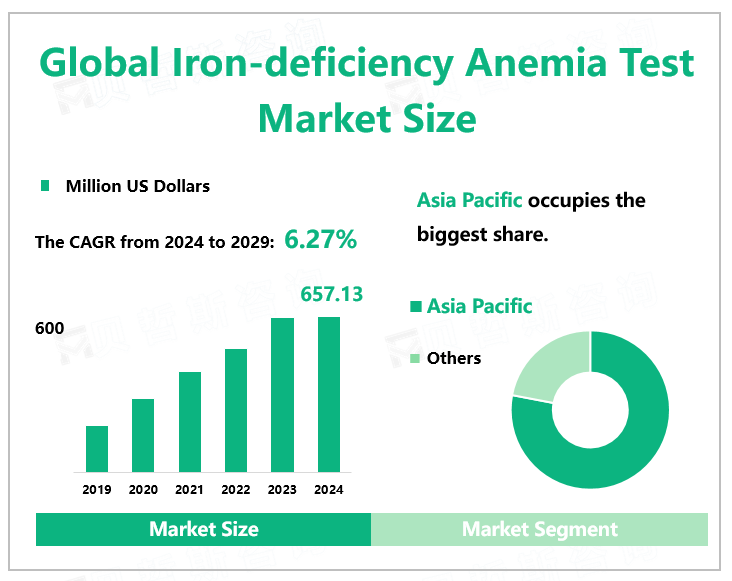Global Iron-deficiency Anemia Test Market Overview
According to Global Market Monitor, the global iron-deficiency anemia test market size is $657.13 million in 2024 with a CAGR of 6.27% from 2024 to 2029.
Iron deficiency and anemia are global health problems and common conditions in daily clinical practice. Iron deficiency affects more than 2 billion people worldwide, and iron deficiency remains the number one cause of anemia. In developing countries, iron deficiency and iron deficiency anemia are usually due to insufficient dietary iron intake, blood loss due to colonization of intestinal worms, or both. In high-income countries, certain dietary habits (such as vegetarian food or not eating red meat) and pathological conditions (such as chronic blood loss or malabsorption) are the most common causes. Once doctors diagnose anemia, they often check for iron deficiency. In iron deficiency, red blood cells are often small and pale. Blood iron and transferrin (proteins that transport extra-erythrocyte iron) levels must be measured and compared.
With the increase in anemia patients worldwide and the development of medical technology, iron deficiency anemia testing will be more commonly used in various regions, especially in developing countries. With the improvement of the medical and health environment, iron deficiency anemia test products will achieve rapid growth in developing countries such as Asia Pacific and the Middle East.

Regional Market
Due to health education and the widespread use of iron-fortified foods, the prevalence of iron deficiency anemia in children in developed countries in Europe and the United States has decreased significantly. However, due to the influence of dietary habits, population aging, and other reasons, iron deficiency anemia still plagues people in many developed countries, especially children and women of childbearing age. As developed countries have sound healthcare systems, more patients with iron deficiency anemia can be effectively tested and treated.
In developing countries like China and India, the local economy is developing fast, and although the healthcare system is not very sound, the government has invested a lot of money in healthcare. This helps more people start to understand the disease of iron deficiency anemia and to detect and treat it promptly. In some less-developed areas. Iron deficiency and anemia can reduce the ability of individuals and the entire population to work, and bring serious economic consequences and obstacles to national development. In areas with relatively backward economic development, the most affected by the iron deficiency problem are the most vulnerable, the poorest, and the least educated.
The World Health Organization (WHO) has published revised guidelines that support policies for the prevention and control of anaemia7. Once implemented, these interventions work to restore appropriate hemoglobin concentrations in individuals and reduce the prevalence of anemia in a population. Monitor and evaluate the implementation of anemia control programs. Improve the identification, measurement, and understanding of anemia among women of reproductive age and scale up coverage of prevention, control, and treatment activities.
|
S |
Ø Anemia is a highly prevalent disease. The increasing prevalence of anemia in different social groups such as babies, adolescents, and pregnant women has become a global problem. Therefore, the demand for related drugs is growing. Ø The increased risk of hemodilution in pregnant women has driven the development of the iron-deficiency anemia market. |
|
W |
Ø Insufficient medical resources. In poor areas in developing and developed countries, medical resources are often insufficient. Many people have symptoms of anemia, but they are not well-tested and treated. Ø Incorrect phenomenon in the test. Depending on the nature of the test method, it is sometimes affected by other diseases in the anemia test, which can cause some errors in the test results. |
|
O |
Ø Lifestyle changes are driving the growth of the anemia market. Ø Governments are investing more in health care, and more people are beginning to focus on the disease. |
|
T |
Ø Strict medical regulatory policies. The development of related products from application to application requires a long process. Ø High investment costs. |
We provide more professional and intelligent market reports to complement your business decisions.